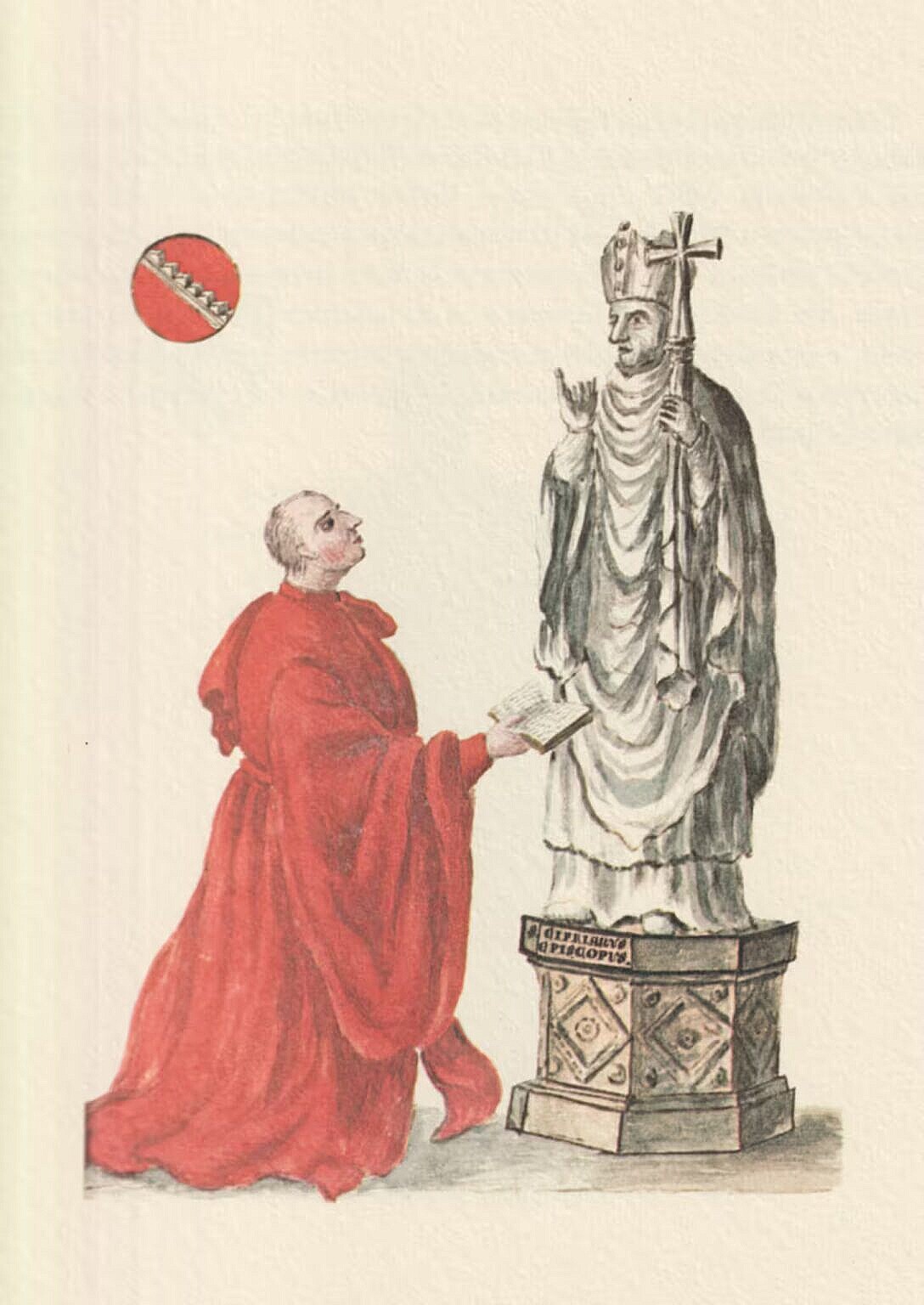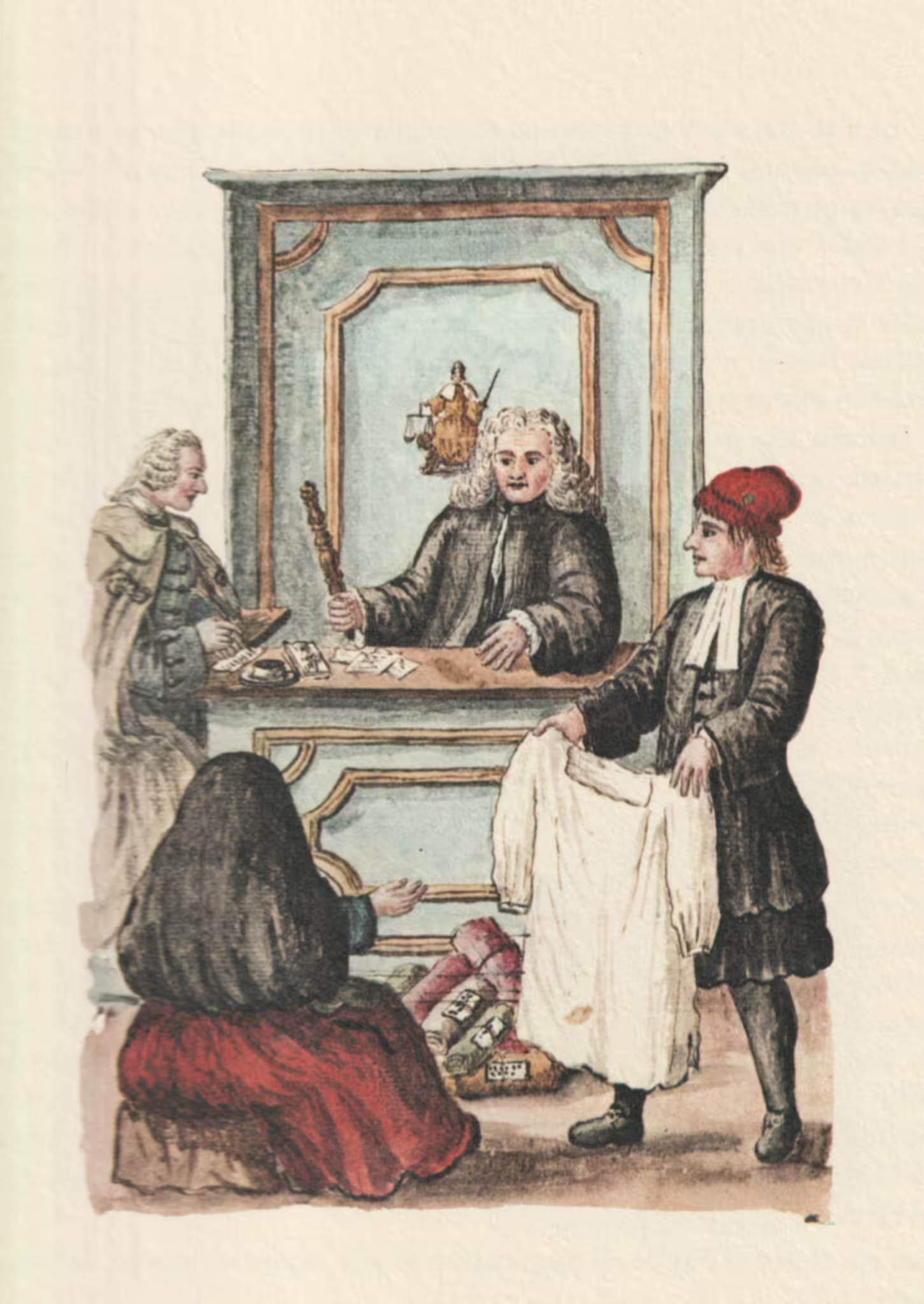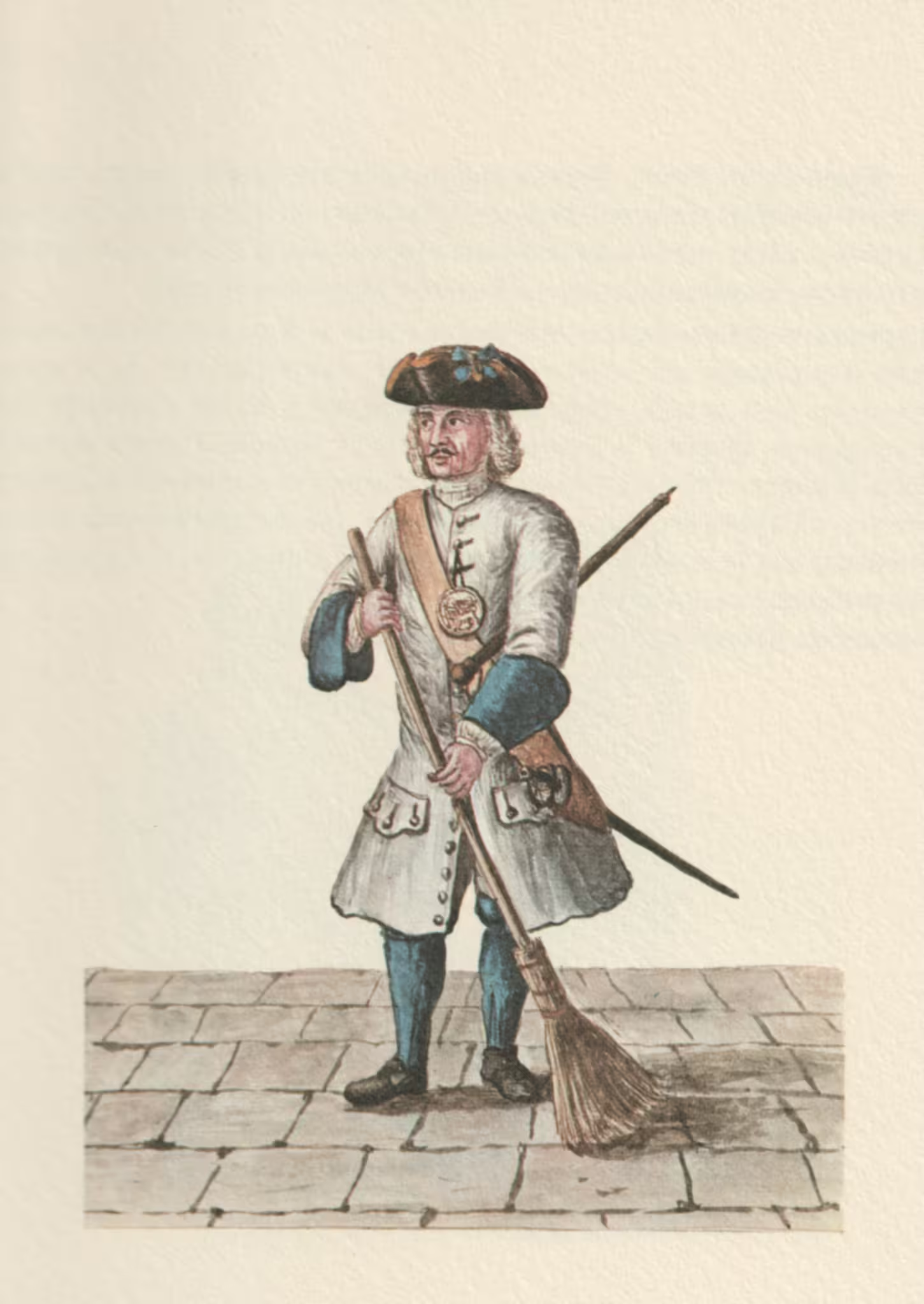The painting depicts the Venetian nobleman Jacopo Gradenigo (c. 1350–c. 1420), wearing the vesta — long robe — with wide sleeves and a stole across the left shoulder.
This dress was typical of the Venetian aristocracy.
Jacopo Gradenigo was a forefather of Pietro Gradenigo, the patron and employer of Grevembroch. He is depicted praying in front of a statue of St Cyprianus.
Source: Gli abiti de veneziani di quasi ogni età con diligenza raccolti e dipinti nel secolo XVIII, by Giovanni Grevembroch (1731–1807), which in four volumes contains over six hundred watercolours of how Venetians dressed in the 1700s.

Giacomo Gradenigo Cavaliere
In addition to what we note from the Portrait of Giacomo Gradenigo, painted by the famous Padovadino,1 we are documented, that already for more than two centuries the Knights, his peers, wore a Toga with open sleeves, which was used by them until 1636; that on the 15th of March the Great Council reserved this prerogative only to the primary Dignities, and it declared, that even those awarded the Equestrian Rank should dismiss it, and rather appear on non-solemn days in a tight Robe, with the gilded Belt, and with the golden Ornament on the Stole.
If we have to represent the ancient style, we should take a copy of the above-mentioned picture, and more willingly because on this occasion we will recall something related to the most serious Senator.
Giacomo was therefore called Belletto, and he was a descendant of the worthy Doge Pietro.
Proposed to several urban magistrates, he went to Friuli in 1383 as Superintendent, a time when the people of Udine desired an alliance with the Venetians, in order to be protected from calamities.
Nine years later he twice went to Padua, in the figure of Podestà, according to the wishes of Francesco da Carrara,2 for which commission he became Ambassador to our Senate, procured for that Prince the aggregation to the Venetian Nobility, with a Diploma, signed on November 24, 1392.
Returning to the duties of the Fatherland, he was given those of Councillor, then as Superintendent in Albania, of Sage of the Militia, of Rector of Chania, and of Podestà in Ravenna in front of the Polentani.3
However, a singular Codex is preserved, which contains the History of the Gospels; which he expounded in terza rima,4 for which he was included in the Catalogue of the most respectable Italian Poets.
Gradenigo died about 1419, and was buried in the Church of SS. Cipriano di Murano,5 the patronage of his conspicuous family, still being seen there in remembrance under the noble coat of arms, on a marble tombstone, the following verses.
I do not abandon the patronage there
Of Saint Cyprianus, who has much reason,
Eh! Of the abbot still the election.6That the Coat shows clearly in this roundel,
That the Gradonico Jacomo, Yes, it is he
The Knight and the Descendants of him.
Translator’s notes
- The painter Lodovico Leoni (1531-1606) was also known as Il Padovadino. ↩︎
- Francesco Novello da Carrara — or Francesco il Novello — (1359–1406) was the last ruler of the Duchy of Padua. ↩︎
- The Polentani were the Da Polenta family, which ruled Ravenna in the period. ↩︎
- Terze rima is a poetic verse form, with three-line stanzas and a specific pattern of rhymes between stanzas. ↩︎
- The ancient church of San Cipriano on Murano was demolished in the 1830s. ↩︎
- The Gradenigo family had the right of patronage over the Church of San Cipriano on Murano, but the position of abbot was vacant at the time of death of Jacopo Gradenigo. The later appointment was made by his son. See Gambino (2002). ↩︎

Original Italian text
Giacomo Gradenigo Cavaliere
Oltre ciò che rileviamo dal Ritratto di Giacomo Gradenigo, dipinto dal celebre Paduanino, siamo documentati, che già più di due secoli li Cavalieri di Lui pari portavano una Toga a Maniche aperte, la quale fù da essi usata sino al 1636; che a 15 di Marzo il Maggior Consiglio riservò tale prerogativa alle sole primarie Degnità, e dichiarì, che anco gl’insigniti del Grado Equestre la dimettessero, e più tosto comparissero ne giorni non solenni in Veste stretta, con la Centura dorata, e con l’aureo Ornamento sopra la Stola.
Dovendo Noi rappresentare la foggia antica prendessimo Copia dal Quadro sopraccennato, e più di buona voglia, perche con questa occasione rammentaremo qualche cosa rapporto al gravissimo Senatore.
Giacomo adunque si denominava Belletto, e fù discendente del benemerito Doge Pietro.
Proposto a diversi urbani Magistrati, andò Proveditore nel Friuli del 1383; tempo in cui gli Udinesi desideravano l’Aleanza de Veneziani, ond’essere protetti nelle calamità.
Nove anni dopo spiccò Egli due volte in Padova, in figura di Podestà, secondo le brame di Francesco da Carrara, per cui comessione tradottosi Ambasciadore al nostro Senato, procacciò a quel Principe l’aggregazione alla Veneta Nobiltà, con Diploma, segnato a 24 Novembre 1392.
Ritornato alle incombenze della Patria, le furono addossate quelle di Consigliere, poi il Proveditore in Albania, di Savio sopra le Milizie, di Rettore alla Canea, e di Podestà a Ravenna in vantaggio de Polentani.
Si conserva tuttavia un Codice singolare, che contiene la Storia Evangelica; da Lui esposta in terze rime, per il che fù annoverato nel Catalogo de più riguardevoli Poeti Italiani.
Morì il Gradenigo circa il 1419, e fù sepolto nella Chiesa di SS. Cipriano di Murano, Juspatronato di sua cospicua Famiglia, veggendosi tuttora ivi per rimembranza sotto gentilizio Stemma, in marmorea Lapide, li seguenti versi.
Del Patronato Quivi Non Abscondo
De Sancto Cypriano Cui N’Ha Ragione,
E! Del Abate Ancora L’Elettione.Che L’Arma El Mostra Claro In Questo Tondo,
Grevembroch (1981), vol. 1, p. 37.
Ch El Gradonico Jacomo Si È Quello
El Chavalier Et Descendenti D’Ello.





Leave a Reply